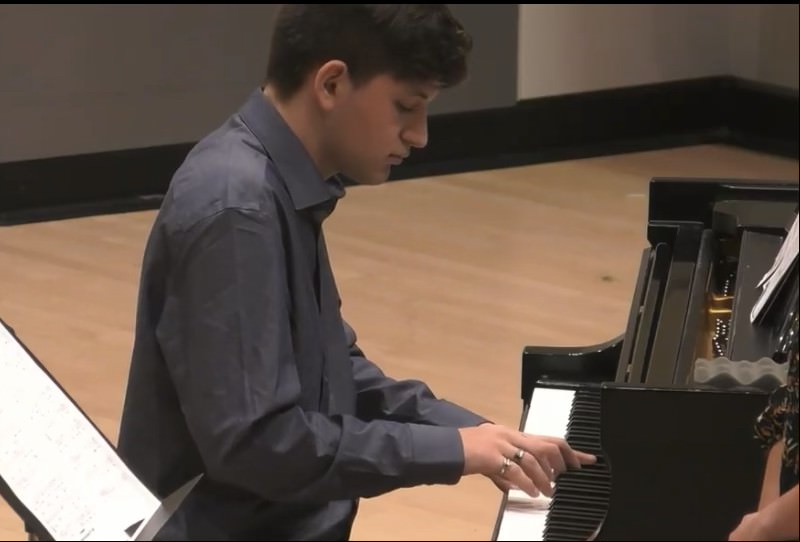Swinging with Style
The musical journey of Jazz musician Roman Newhouse
—By Rohan Puri
Music is a language understood around the world. It breaks barriers of culture, language, and race. Some people, however, do not view music simply as recreation—they practice music as a profession. Roman Newhouse, student at the University of Michigan’s School of Music, Theater, and Dance, is one of those people. Honing his skill in jazz piano and learning how to educate future musicians, Newhouse devotes each day of his life to music while enjoying it everytime.
Humble beginnings
A sophomore with a dual major in choral music education and jazz piano performance, Newhouse has a lot on his plate. Growing up in Chicago, his father’s job as a teacher at the Old Town School of Folk Music was his initial reason for his involvement in music. Here, Newhouse participated in numerous dance and singing programs in bluegrass, folk singing, and jazz from a very young age.
When applying to colleges, U-M’s SMTD program was not his first choice. Initially, simply thinking about pursuing jazz, Newhouse had his eyes on the University of Miami’s Frost School of Music, another top music school. After gaining admission into both music schools, Newhouse faced a decision of where to accept. But upon touring U-M, Newhouse realized “the second that I visited, I just, I knew it was the place; the faculty was perfect, the location, [and] obviously the quality of the program.” He recalls how, during his visit, a jazz professor personally invited him to a jazz showcase of SMTD students. There, he said, the talent was amazing and that he wanted to be on the same stage one day. After this visit, he went on to visit Miami, and it was just not the same. “And I was just like, yeah, it has to be Michigan.”
The current chapter
Newhouse is a busy student when at school, two years in on his track to graduation. His day begins with an 8 AM musicology course, learning about the history of music through the ages. He then practices piano for at least four to five hours until his next class at 2:30. He describes this amount of practice time as normal for most students in SMTD, saying, “Every school has a different culture or…for practicing, you know, either created by their professors or their peers or themselves.”
Despite this pressure, Newhouse said, SMTD has a good balance between competition and self improvement. The Briggs Chamber Music Competition, for example, calls for “at least 40 minutes of music and at least two complete works.” Newhouse explained that this competition can become cutthroat, with students overworking themselves in order to have a chance at beating out others. On the other hand, he said, small jazz improvisation contests do a good job with motivating students to better their own skills without necessarily pitting students against each other.
Newhouse revealed that he and other students each have a one-hour personal lesson with their main professor once a week. This is possible due to SMTD boasting “more than 155 full-time faculty members.” This type of luxury is an important factor as to why students want to attend SMTD. In these private lessons, students are able to have individual attention and improve their skills. Newhouse uses this time to work on his jury pieces. A hard task for any, Newhouse has to learn forty different jazz pieces by the end of the year and must perform them in front of a panel of judges who discern whether or not he has shown mastery. This is a grueling and meticulous process, but Newhouse explained that the help that he receives from professors allows him to improve markedly and be prepared.
The big stage
The biggest reason that Newhouse and many other students select SMTD as their home for four years is because of the endless performance opportunities. Performing professionally is the end goal for the majority of students, so receiving opportunities to be on stage is a major draw. Describing his last semester, Newhouse said, “I had my professor actually ask me to fill in and sub for gigs for him.” These jazz performances are professional roles that help to gain experience and presence on stages. These can occur as close to home as Detroit or as far away as California or Louisiana, preparing students for their future professions. Furthermore, Newhouse makes appearances at the Blue Llama Jazz Club, right here in Ann Arbor, playing jazz piano with other SMTD students for patrons as they dine and drink.
Newhouse has worked extremely hard to get to where he is today. The work is far from over, however. Newhouse and other SMTD students must sharpen their skills year after year in order to be at the top of their game. Fortunately, Newhouse studies at one of the best establishments in the country, so he sits in a great position. The next time you sit down at a restaurant in Ann Arbor and hear live music, look out for Roman Newhouse; there’s a great chance that the music you hear is a product of his skills and the great amount of work he and other students put in each day.
Feature photo, Roman Newhouse Playing a Recital; Photo Credit, Roman Newhouse

